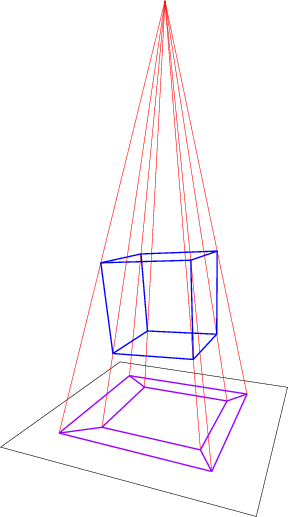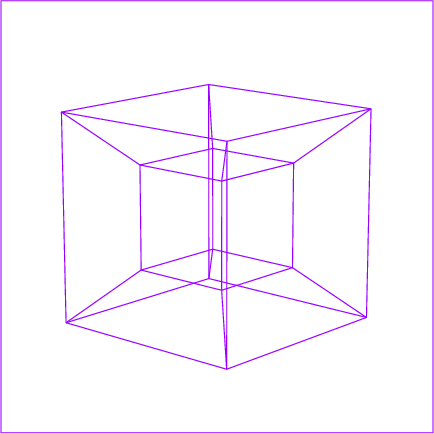Visualizing the 4th dimension.
The animations below accompany an introductory talk on high-dimensional geometry.
Mathematically, the second was made by putting a "light source" at a point $(0, 0, 0, h)$ (with $h > 0$) and sending each point $(x, y, z, w)$ (with $w < h$) to $\frac{h}{h - w}(x, y, z)$.


First things first: your brain is simply not made to visualize anything higher than three spacial dimensions geometrically. All we can do is using tricks an analogies, and of course, the vast power of abstract mathematics. The latter one might help us understand the generalized properties of such objects, but does not help visualizing it for us 3D-beings in a familiar way.
I will keep things simple and will talk more about the philosophy and visualization than about the math behind it. I will avoid using formulas as long as possible.
The analogy
If you look at an image of a cube, the image is absolutely 2D, but you intuitively understand that the depicted object is some 3D-model. Also you intuitively understand its shape and positioning in space. How is your brain achieving this? There is obviously information lost during the projection into 2D.
Well, you (or your brain) have different techniques to reconstruct the 3D-nature of the object from this simplified representation. For example: you know things are smaller if they are farther away. You know that a cube is composed of faces of the same size. However, any (perspectively correct) image shows some face (the back face, if visible) as smaller as the front face. Also it is no longer in the form of a square, but you still recognize it as such.
We use the same analogies for projecting 4D-objects into 3D space (and then further into 2D-space to make an image file out of it). Look at your favorite "picture" of a 4D-cube. You recognize that it is composed of several cubes. For example, you see a small cube inside, and a large cube outside. Actually a tesseract (technical term for 4D-cube) is composed of eight identical cubes. But good luck finding these cubes in this picture. They look as much as a cube as a square looks like a square in the 2D-depiction of a 3D-cube.
The small cube "inside" is the "back-cube" of the tesseract. It is the farthest away from you, hence the smallest. The "outer" cube is the front cube for the analogue reason. It might be hard to see, but there are "cubes" connecting the inner and outer cube. These cubes are distorted, and cannot be recognized as cubes. This is the problem of projections. A shape might not be kept.
Even more interesting: look at this picture of a rotating tesseract. It seems like the complete structure is shifting, nothing is rigid at all. But again, take the anagoly of a rotating 3D-cube in a picture. During the process of rotation, the back face is becoming the front face, hence shifting its size. And during this process it even loses its shape as a square. All line lengths are changing. Just a flaw of the projection. You see the same for the rotating tesseract. The inner cube is becoming the outer one, becoming bigger because it is becoming the "front cube".
The projection
I just talked about projections. But a projection is essentially the same as a shadow image on the wall. Light is cast on a 3D-object and blocked out by it and you try to reconstruct its shape from the light and dark spots left by it on the wall behind it. Of course we cannot talk physically about a 4D-light source and light traveling through 4D-space and hitting a 3D-wall and casting a 3D-shadow. As I said, this is just pure analogy. We only know the physics of our 3D-world (4D-spacetime if you want, but there are no four spacial dimensions, but one is temporal)
So what are you projecting on? Well, you are projecting on our 3D-space. Hard to imagine, but our 3D-space is as much to the 4D-space as a simple sheet of paper is to our space $-$ flat and infinitely thin.
How crude these depictions are will become evident when making clear how many dimensions are lost in the process. Essentially you are projecting a 4D-object onto a 3D-space and then onto a 2D-image so we can show it on screen. Of course, our brain is clever enought to allow us to reconstruct the 3D-model from it. But essentially we go from 4D to 2D. This is like going from 3D to 1D, trying to understand a 3D-object by looking at its shadow cast at a thin thread. Good luck for 2D-creatures understanding 3D from this crude simplification.
Another way to visualize a 4D object is to imagine it passing through our 3D space.
First consider a flatlander (an inhabitant of an imaginary 2D universe). If you were to push a sphere through his 2D universe, how would it look to him? A dot would suddenly appear from nowhere, become a tiny circle, grow to some maximum size, shrink, and then disappear.
Now imagine a 4D being pushing a hypersphere through our 3D universe. A dot would appear, become a small sphere, etc.
How about other shapes? The cube / hypercube would appear differently depending on how it entered the lower dimension space. If it hit flat on then it would seem that a square / cube had appeared from nowhere, stuck around for a bit, and then suddenly vanished.
Consider a 2D mathematician trying to understand these observations. Would he be able to visualize the 3D objects? If you were able to communicate with him, could you help? Now, imagine that you are talking to a 4D mathematician who is trying to explain the 4D shapes that he is pushing through our universe.